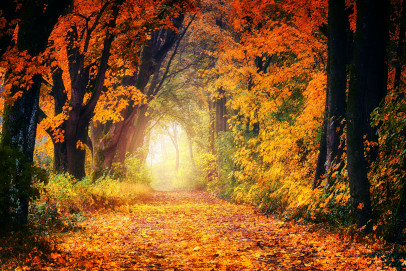Moving through Autumn into Winter
By Sue Hargreaves

In the coming weeks the dark will be more noticeable and the waning cycle of the sun will reach its fullness at the Winter Solstice, after which we will start to see a return of the light. The winter solstice is the day of the year with the fewest hours of daylight. This year, in the Northern Hemisphere , it will occur on Sunday December 21st.Our challenge during this time is to both embrace the darkness as well as bringing light into the darkness. Darkness offers us rest, regeneration, and renewal during the autumn-winter months, but it’s important to lighten up dark days with images of light. Our practice offers us many ways of lifting our spirits and lightening up these dark days. Sun imagery can be used to lift the mood and shake off seasonal blues and Surya Namaskar is a series we can use.
Sun Salutes were practised in India probably since the end of the Vedic Times (1550-500BC). They were not regarded as a part of the Asana system in Hatha Yoga until recently and began as salutations to the rising & setting sun and were a means to communicate to a visible source of life on earth.
They were introduced to the West in a slightly reduced form by Raja Pant in the 1920’s and since the 1940’s they became widely popular along with the Asanas.
There are various interpretations and have 12 postures ( 12 aspects of the sun) which should move smoothly one into the other, incorporating rhythmic breathing , mantras and visualisation.
Surya Namasaker can be performed slowly , like a moving mediation, or quickly, to release toxins. Either way, it builds stamina. Improves bodily functions , warming the body through improved circulation, removing tensions and increasing flexibility of the whole body, especially the spine , and strengthens all the muscles.
The inner mood is important and is developed by concentration on the movements , breath & mantras. The whole body is brought into balance giving a feeling of strength and well being.
There are different ways of using the breath.
Inhale & exhale naturally with the movements .
Inhale or exhale into a posture , then hold the breath whilst taking a further breath.
Or hold the posture for 2 or 3 even breaths . This will help you move further into a posture , for each breath will help you to relax and adjust.
You may wish to focus on the Chakras and work silently. Or focus on the chakras and use the mantras associated with them . This means that as you hold a posture, you focus your attention on the relevant area and then silently repeat the mantra.
Another way is to move into the posture , focus your attention on the relevant area and picture the colour associated with it.
Music can be used. Something lively if that is how you feel or something soft and calming if you wish to be more meditative.
Counterpose
Rest on your back
Include a lateral spinal bend & rotation , shortly before or after the sequence. Or you may have your own set of movements to precede and follow your sequence.
Contra indications & adaptations
In raised arm position , keep the chin on the chest if there are neck problems.
Use bent knee position for forward bend , if there are lower back problems.
For 9 pointed position problems: go forward onto chin and forearms, or just do a little ‘dip’ when arms are weak.
For lunge position , bend the opposite knee e.g right knee to floor, lift up the left hand & bring the left foot forward, lifting it into position if necessary, or make several small steps & lift up the shoulder, to let the knee through. Helpful when the hip or knee is stiff.
You will be aware there are many variations of Surya Namsakar with varying degrees of ease or difficulty. Choose one that suits you and enjoy practising . It is good practice to stick to one so that the mind is freed.
